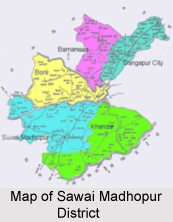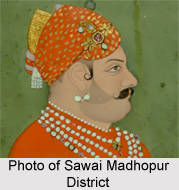 Sawai Madhopur District is one of the administrative districts of Rajasthan. It has its headquarters located at Sawai Madhopur, which is one of its chief towns. Sawai Madhopur is an important tourist destination in Rajasthan.
Sawai Madhopur District is one of the administrative districts of Rajasthan. It has its headquarters located at Sawai Madhopur, which is one of its chief towns. Sawai Madhopur is an important tourist destination in Rajasthan.
Location of Sawai Madhopur District
Sawai Madhopur District is located at 25 degree 45 minutes to 26 degree 41 minutes north latitude and at 75 degree 59 minutes to 77 degree eat longitude. Sawai Madhopur District has an area of around 4500 sq kms. It shares its boundaries with Dausa District on the north, Karauli District on the northwest and west, Kota District on the southwest, Bundi District on the southeast, and Tonk District on the east.
History of Sawai Madhopur District
This district came into existence in the 18th century. Before this time the region was famous as Ranthambore. People from across the world come to spend their vacations here. Since the economy of Sawai Madhopur District is largely dependent on tourism, all kinds of measures are taken to promote tourism. History of Sawai Madhopur District states that it was founded in 1765 AD. It was named after Sawai Madho Singh who fortified it and established it as a town. Sawai Madhopur town is known for Ranthambore Tiger Reserve and a place of historical importance. According to historical accounts, the Muslim conquest brought about major changes in the political map of northern India. In Rajasthan, the Chauhan kingdoms of Sapada-laksa disappeared; the grandson of Prithviraj Chauhan established himself at Ranthambore and ruled as feudatory of the Sultan of Delhi. Rana Kumbha captured the Ranthambore Fort the middle of the 15th century. After the death of Aurangzeb, the fort was taken over by the rulers of Jaipur.
 Demography of Sawai Madhopur District
Demography of Sawai Madhopur District
The total population of Sawai Madhopur District is 1116031, out of which male population is 590716 and female population is 525315. Further, as per the 2001 Census records, total urban population of Sawai Madhopur District is 212575 and rural population is 903456.
Culture of Sawai Madhopur District
Culture of Sawai Madhopur District is really colourful including several fairs and festivals. One of the highly celebrated fair of this district is Ganesh Chaturthi Fair. It is in fact the largest fair of Sawai Madhopur and is organised on Bhadav Shukla Chaturthi at Ganesh Temple, Ranthambore Fort. This is a very popular fair and is attended by people from distant places. This fair is organised for three days. Another important fair that is Chauth Mata Fair is organised on Magh Krishna Chaturthi. Thousands of devotees attend this fair. Shivaratri fair is another most popular and largely celebrated fair of Sawai Madhopur District.
Administration of Sawai Madhopur District
The administrative structure of Sawai Madhopur District includes four sub-divisions, seven Tehsils and three sub-Tehsils. Further there are five Panchayat Samitis and 197 Panchayats. Administration of Sawai Madhopur District also comprises two Municipalities and 800 revenue villages.
Tourism in Sawai Madhopur District
The city of Sawai Madhopur houses the Ranthambore Tiger Reserve. Further, there are several other places of interest around Sawai Madhopur. While the travellers can visit the neighbouring cities of the state, they can also check out the temples and forts that are located outside the district including Rameshwaram Dham, Chauth Mata Temple, Khandar Fort, etc. All these places are worth visiting.
Sawai Madhopur is well accessible from cities such as Udaipur (Rajasthan), Mount Abu, Jaipur and others. Local transports are available to tour the city.






